“She is an entrepreneur with a capital E”, is how my husband, Anil Mulchandani, described his aunt Mrs. Vanita Ram Mulchandani nee Chandra Sadhwani when he introduced his family to me. Vanita Auntie is married to Ram Uncle, the elder brother of my father-in-law, Shri Mohan K Mulchandani. Born in 1939 in Hyderabad, Sindh, to the Sadhwani family, she and her family had to shift to Calcutta during the partition of India in 1947. She was 9 years old then. She married into the Mulchandani clan in the year 1964 and settled in Ahmedabad.
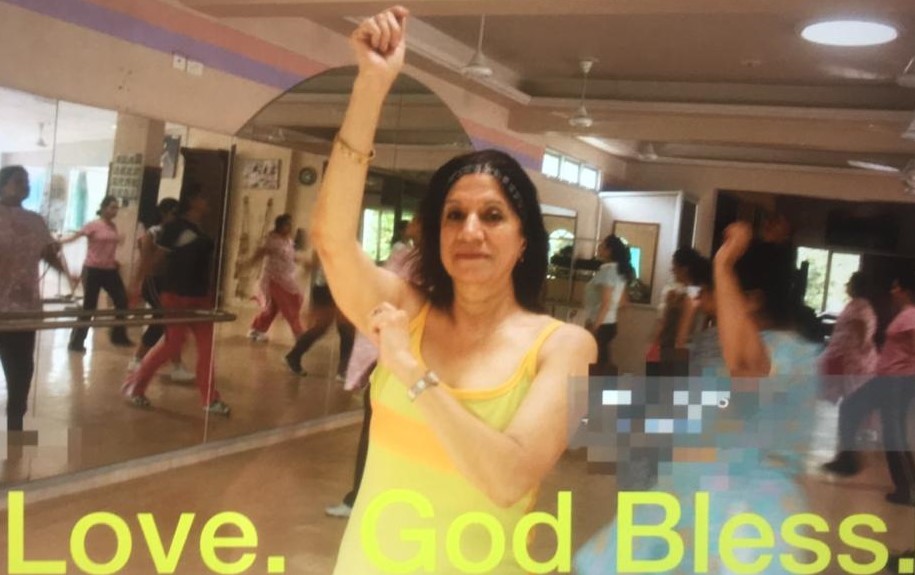
In 1979, when people of Ahmedabad were not even aware of the words ‘aerobics ‘or ‘gym’, she started Vanitarama Health Plus, a gym and fitness studio where she taught aerobics, yoga and later, Zumba , and became a pioneer in Ahmedabad in the field of health and fitness. She ran the class for 37 years and retired at age 76 in 2017- a remarkable feat, indeed!
She has got the entrepreneurial streak from her father, Shri Chotirmal Dhanomal Sadhwani, who rose from the proverbial rags to riches, only to lose most of it again during the Partition of India. But never the one to give up, he continued working hard and smart, and brought prosperity to the family again in Calcutta post partition.
This is the personal account of Vanita Auntie’s life in Sindh and Calcutta.
Hyderabad House
“We had a beautiful house at Mukti Gitti (lane) at Hyderabad, Sindh before the partition. My father built another house at the back of the first one. This new house (nao ghar) had modern amenities like a flush in the washroom. It even had a life-sized stuffed gorilla and a radio which were novelties in those days. We had rooms upstairs and downstairs with a dalaan (compound) which had a wooden swing. There was a gate at the entrance of the gitti which was closed at night. My sister, Lal, did visit Hyderabad, Sindh, in December of 1983 and checked out our house. But the residents did not allow her inside, so she had to take photos of the house from the neighbour’s place. The nameplate with my father’s name is still on that house.”
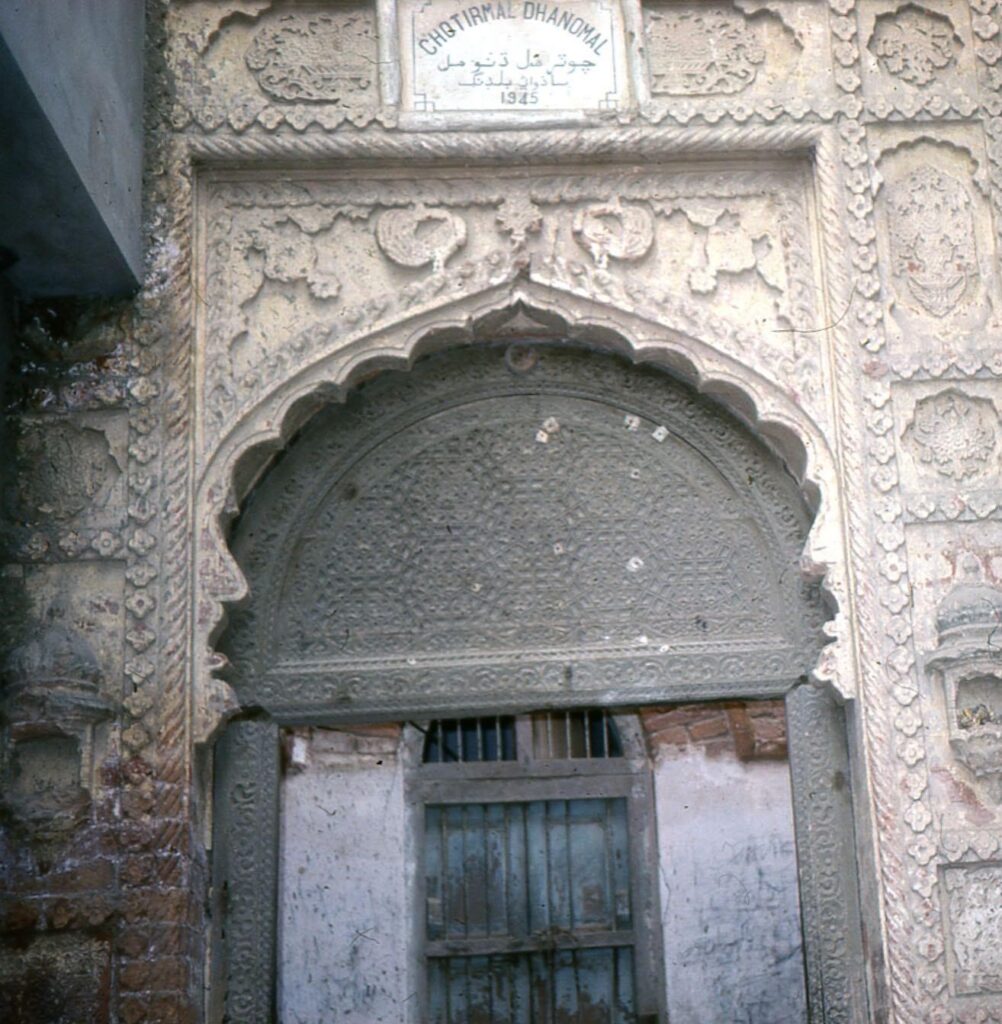
Pic: The Name Plate on the House in Hyderabad, Sindh Still Bears the Name of My Father
My Father
“My father started as a piri waro (a wandering vendor) moving around with a gathri (a bundle) selling goods in Hyderabad. With his hard work and a sharp mind, he made enough money to start various businesses in partnership with other Sindhis. He built, bought, and sold properties. He rented out the land he bought. He even started a shop, Chotirmal and Sons, in Calcutta that dealt in jewellery. He travelled to and fro from Hyderabad to Calcutta for business, which made it easier for the family to settle in Calcutta after the partition of India in 1947. He later supervised and got a building, Sati Niwas (named after my mother) made in Calcutta post-partition to accommodate my brothers and their families. I think he was a brilliant man who rose in life by his vision and determination.”
My Mother
“My mother was my father’s second wife. Her maiden name was Radha Daswani, while her married name was Sati. She was always well-dressed. She wore suthan (narrow palazzo pants), a light voile kurta, and a thin muslin rawo (a long dupatta/scarf) covering her head. Even when she was ill in her later life, I always found her taking care of her appearance and wearing pretty nightgowns at the hospital. She never had to do any housework in her life. Since she was always found rocking away in a jhula (swing), she was called Jhulewari Mai ( The Lady with the Swing). My Mama (maternal uncle) worked in Indonesia so my Mami (maternal aunt) stayed with us and helped around the house. She looked after us children very well- bathing and feeding us. We must have had part-time servants doing household chores. I do remember a dhobi called Khatti who lived downstairs coming in for the laundry.”
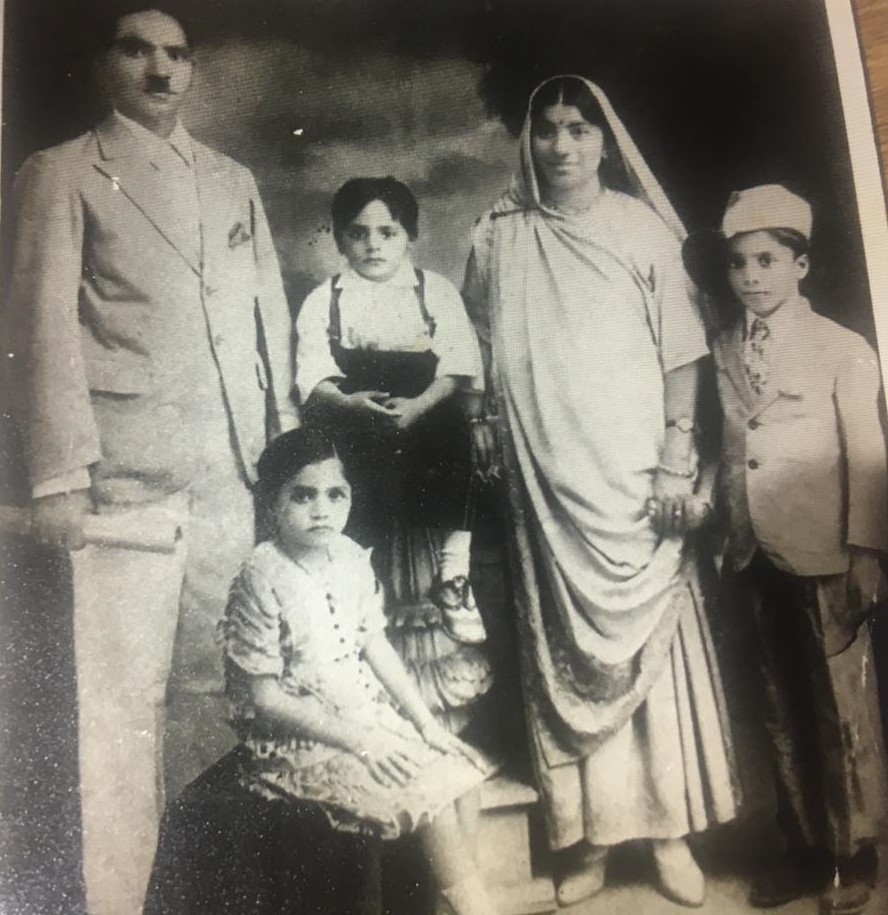
Pic : My Mama and Mami with Lal sitting in front
Our Childhood
“My father did not have any child from his first wife but had 17 children from the second one. Two of the children did not survive. So we were fifteen of us – 10 brothers and 5 sisters named in sequence as Ram, Lachu, Kishu, Bhagi, Lal, Lakh, Mul, Vashi, Arjan, Duru, Nirmala, Balu, Chandra (that’s me), Sheila and Prakash. My elder sister, Lal, was the first girl child after four sons and was everyone’s favourite in the family. Four more brothers followed her so she did not have any competition for quite some years. She was so well-known in the Sindhi community that we four younger girl siblings were identified as her sisters -we were not significant enough to merit our own identity. I envied her collection of jewellery and always wondered when I would get to wear it.
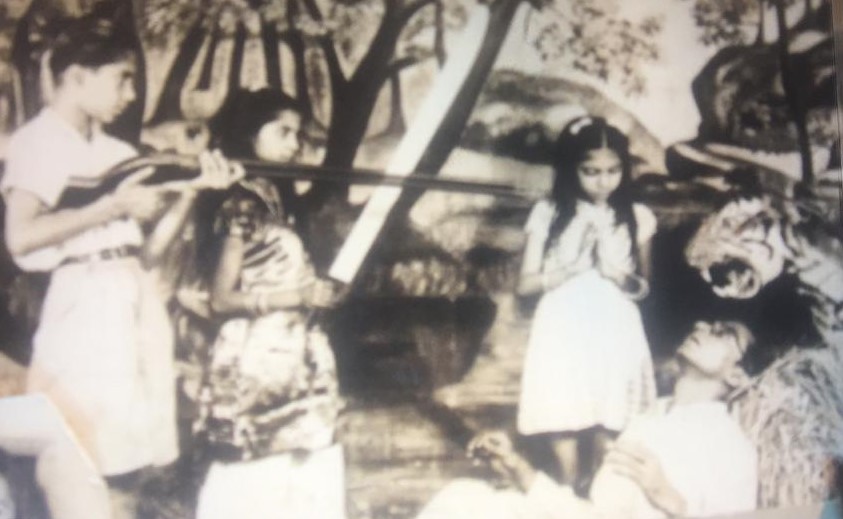
This is a photo of the Sadhwani siblings taken in a photo studio – a common trend in those days. Bhagi is in the mouth of the tiger, Arjan and Duru with the gun and the sword. Nirmala is the one praying.
We had a newspaper vendor right outside the gate of Mukti Ghitti. Every afternoon, around 3, when the newspapers came in, we children would rush to buy one to read a comic strip on dinosaurs. We were pretty excited to know what happened next. We siblings played carrom and ludo in our free time. My elder brother would put away the pawns of the games so carefully after we were done.
Mukti Gitti was a big street with our aunt staying at the other end of the lane. In the evening we played with the children of our neighbours. Excited and famished from playing so much, we would run into the house for the night. The evening meal would be cooking on the sigri (a clay stove) and we were often given the ras (gravy) of daag ji bhaji (vegetables cooked in a spicy onion gravy) on a slice of bread to temporarily assuage the hunger . Tired, we would go off to sleep soon after without waiting for dinner. Later at night, our father would prop us up while we were sleeping and make us drink a glass of milk. The habit of drinking milk before turning in for the night persists till today. Even after a hearty dinner at parties, we siblings need a glass of milk before sleeping.
We did not have a dining table and had our meals on a marble diwan. I remember someone accidentally spilled hot moong dal on my foot which burnt it badly. My brother, Lakh, carried me to the doctor for the change of bandage every day. Well, I hated moong dal after that. It is only now I have got over my aversion to it.
My eldest brother Ram got married in 1944 and he went to the bride’s place in a car. I remember I was the only one among the siblings who were allowed in the car. I felt quite special and became quite an object of jealousy among the siblings. The newly-wed couple stayed in the room upstairs. I would often visit them and they would bribe me to go back downstairs with huge slabs of chocolates. In those days, we got fabulous Black Magic chocolates in a beautiful box from London. Of course, the chocolates became an incentive for me to visit upstairs more often.
I was fussy about the food and my mother always got the dinner made to my liking. I was particular about my clothes too. We dressed in stylish velvet frocks that were in trend in those days. My elder sister, Lal, ensured that we looked our best.
Lal, being older, remembered those times more vividly. According to her, while growing up, we had the best of everything – food, clothes, parents, family. She wished for the same set of parents and family in her next life too. ( Lal passed away on 31st August 2019 at the age of 94).”
Partition Of India
“We had to leave our lovely houses and lands behind. With a little gold and money, we came to India to restart our lives .
Since my father already had a jewellery shop in Calcutta, he sent us siblings there on a train during the partition. The first-class compartments in those days were very comfortable with bathrooms ensuite. We were given a few gold coins to hide in our pockets. So we spoke in ch boli (a code language made by inserting the letters ch in every word) whenever we referred to the coins to conceal the fact that we were carrying some from others.
My father fought court cases for years post-partition, but he hardly got anything for the properties left in Sindh.
In Calcutta, influenced by the different cuisines we got exposed to, we tried making dishes such as continental, Chinese and even Burmese khow suey, taught to us by a Jewish neighbour. We also made caramel custard. The family used to Sindhi food did not quite appreciate the new dishes.
Three of my brothers worked at Sheila, the other shop owned by my father. Often when they returned at night, we would have retired to bed. There was a partition separating the dining area and the dormitory-style beds laid out for us. We would fall asleep listening to their stories about the day they had at the shop.”
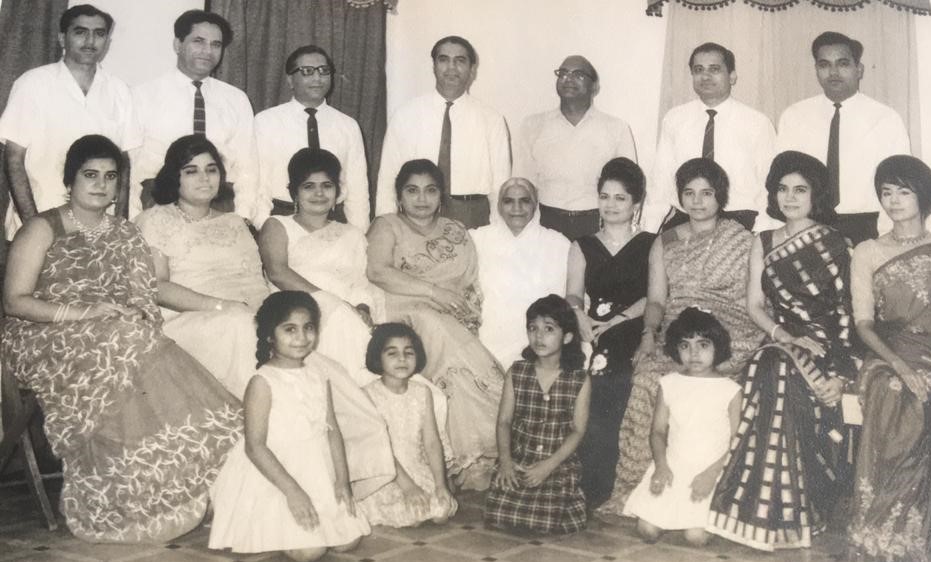
Pic: (from left to right sitting on chairs ) Hoor (wife of Mul) , Koshi (wife of Lakh), Situ (wife of Lachhu), Duri (wife of Ram), Amma ( my mother), Lal, Duru , me (Vanita), and Sheila
(from left to right standing) Mul, Lakh, Lachhu, Ram, Bhagi, Lachhman (husband of Duru), Ram (my husband)
The nieces are sitting on the floor
Some of the favourite Sindhi foods
“I love all kinds of traditional Sindhi food such as koki ( see recipe below) with doudhdh (curds) or tomato bhaji and sai bhaji (a healthy dish made of spinach, fenugreek leaves, tomatoes, bottle gourd, dal, chillies, ginger, etc. I have a sweet tooth for Sindhi sweet dishes like lolo (sweet roasted whole wheat flatbread), tikkis ( cylindrical-shaped sweets encrusted with sugar), seero ( a sweet preparation of roasted whole wheat flour in ghee and sugar) and laddos. I like basically any Sindhi sweet with a lot of ghee and sugar. I often have Sindhi maakhni dal ( thick moong dal with masalas and melted ghee on top – not to be confused with Punjabi dak makhani) on a slice of bread garnished with chopped tomatoes and sev.”
My Notes (Jyoti Mulchandani) :
The Recipe of Sindhi Koki (makes four medium sized kokis)
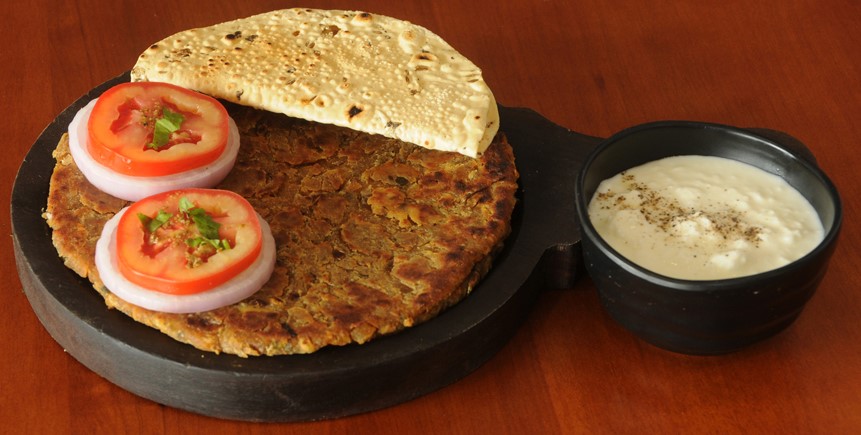
One of the favourite breakfasts of the Sindhis, koki has two versions- one is the spicy masala koki with finely chopped onions, chillies, etc and the other is loonmirchin wari koki with cracked black pepper and salt. The former can be had with curds, pickles or chutneys while the latter one goes well with jeere wara patata (potatoes cooked in tomato gravy with cumin seeds). Here I have included the spicy version of koki- the masala koki.
Ingredients
Whole wheat flour 300 gm
Medium sized onions 2 finely chopped
Handful of chopped coriander and mint
Finely chopped chillies 1-2
Anardana (pomegranate seeds) 1 1/2 tsp (if whole anardana bother you, you can coarsely ground them)
Shahjeero 1 tsp
Ghee 3 tbsp for the dough and 1 tbsp for the top
Salt as needed
Procedure
- Take the flour in a large bowl (thal). Add chopped onions, chillies, coriander, mint, anardana, shahjeero and salt.
- Add melted ghee . Kokis do need a lot of ghee but adding the right amount of it is important. Add enough ghee in the the flour that you can make a dry dumpling with your hand before the water is added.
- Add just enough water to bind one koki at a time. Do not bind the entire dough at one go as the onions will release their juices and make the dough soft. Koki dough does not need as much water as kneading a roti dough does. Add a little water at a time.
- Roll out the koki and roast it on an iron griddle on medium heat. Add ghee on top once done.
- Serve it hot with curds or pickles. Koki tastes great when eaten cold too.
Some facts about Hyderabad, Sindh
1.Hyderabad’s name translates literally as ‘Lion City’- haydar meaning ‘lion’ and abad is a suffix which means a settlement.
2. Hyderabad is the second-largest city, after Karachi, in Sindh. It is the eighth-largest city in Pakistan.
3. It was founded in 1768 by Mian Ghulam Shah Kalhoro of the Kolhora Dynasty, after Khudabad, the then capital of the Kalhoro dynasty, was periodically flooded by the River Sindhu that changed its course in 1757.
4. Hyderabad served as a provincial capital until the British transferred the capital to the Bombay Presidency in 1847.
5. The houses at Hyderabad have windcatchers (mungh) on the roof, funneling cool breezes into the homes below.
Personal Account of Mrs. Vanita Ram Mulchandani
Featured Image: Shrimati Sati and Shri Chotirmal Sadhwani
Pics Credit: Personal Collection of Mrs. Vanita Ram Mulchandani
Pic of Koki : Dinesh Shukla at Anand Sweets, Ahmedabad
Recipe of Koki: Urvashi Dama, Mumbai
Information on Hyderabad, Sindh : Google Search
Jyoti Mulchandani
Ahmedabad
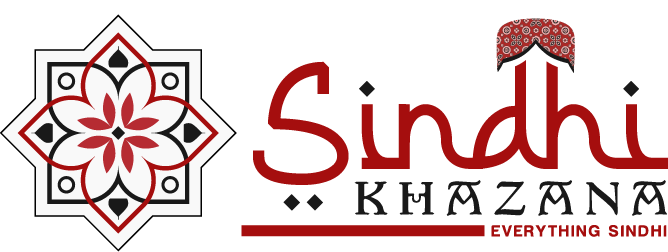
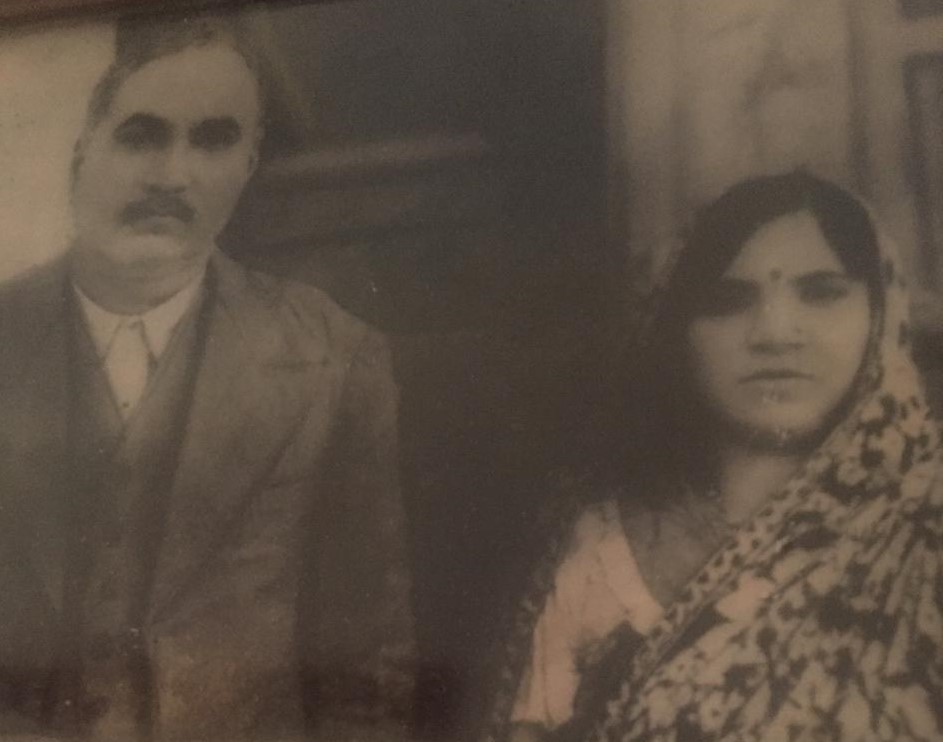
Today I read above mentioned your past history & felt myself proud. Presently I am residing in the surroundings of Clifton area of Karachi since last 03 years while I am originally belonging to Hyderabad Sindh and very well-known there as a Midwife of Hyderabad old City. My family consists over total 06 members including a grandson & a daughter who is MBA from Malaysia. My late father Isserdas Lekhraj Kirpalani use to be a businessman in Hongkong till 1945.It would be a pleasure for me if we remain connected.Thanks.
Great read. Congratulations to all involved in putting this together. My family also lived in Mukti Gitti. If you entered the gate, turned right towards the corner and turned left, our house was the first one on the right. My father, Tharumal Tirathdas Khemlani was a partner with Bhai Pratap of J. Kimatrai in Yokohama and lost it all during the war. I was 6 years old when we left Hyderabad in 1947. I now live in Orlando Florida. My brother, Mangharam Khemlani, who passed away, his son Mohan Khemlani lives in Alexandria, Virginia and travels to Gandhidham and other places frequently. He has also travelled to Hyderabad but his guide could not find Mukti Gitti. He plans to visit the area next year and would love to get some information from you on how to locate Mukti Gitti. If you have some pictures or maps/hand sketches or nearby neighborhood information, I would be much obliged if you would kindly email me anything you have at tellmoti@cfl.rr.com. Thank you very much and look forward to hearing from you.